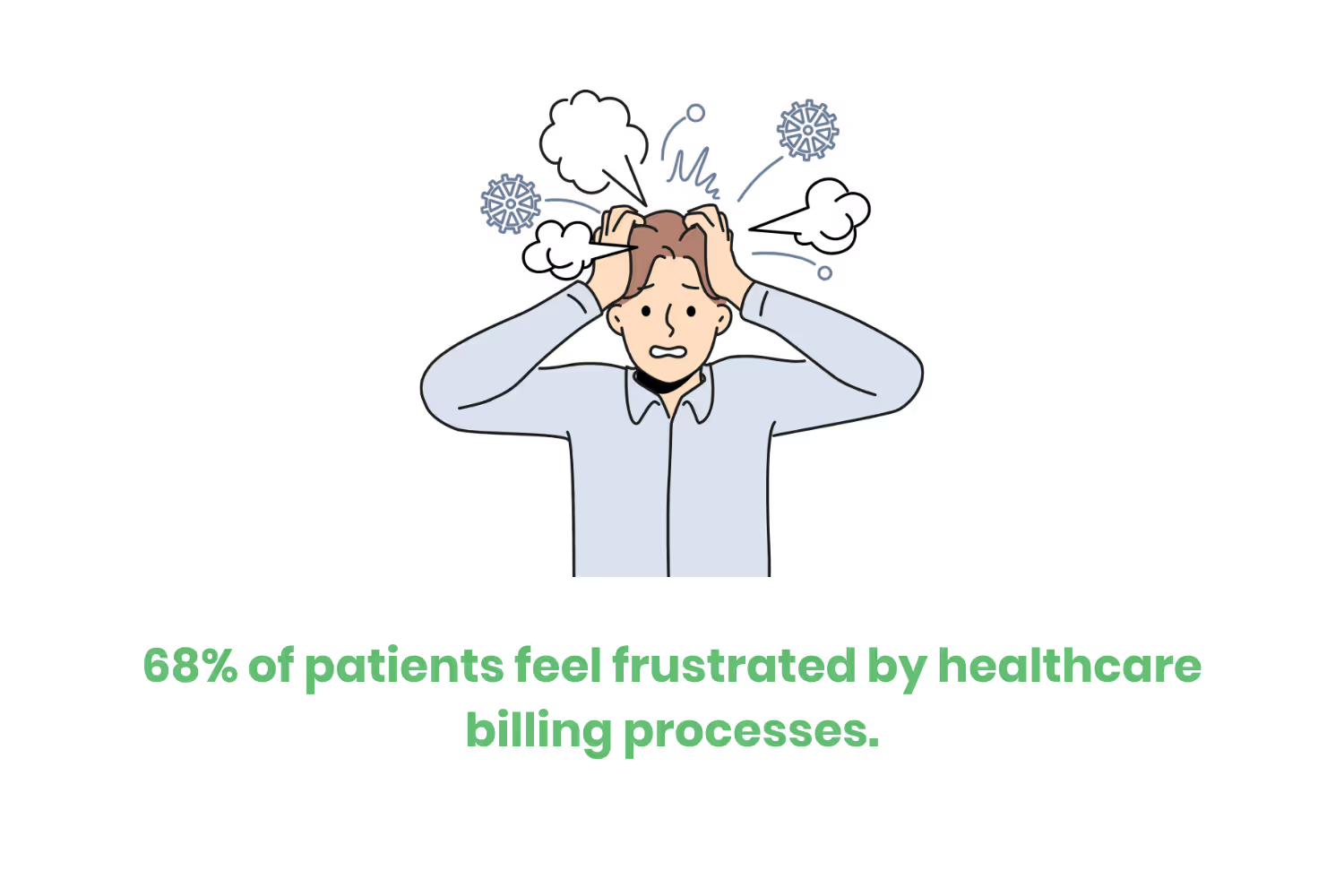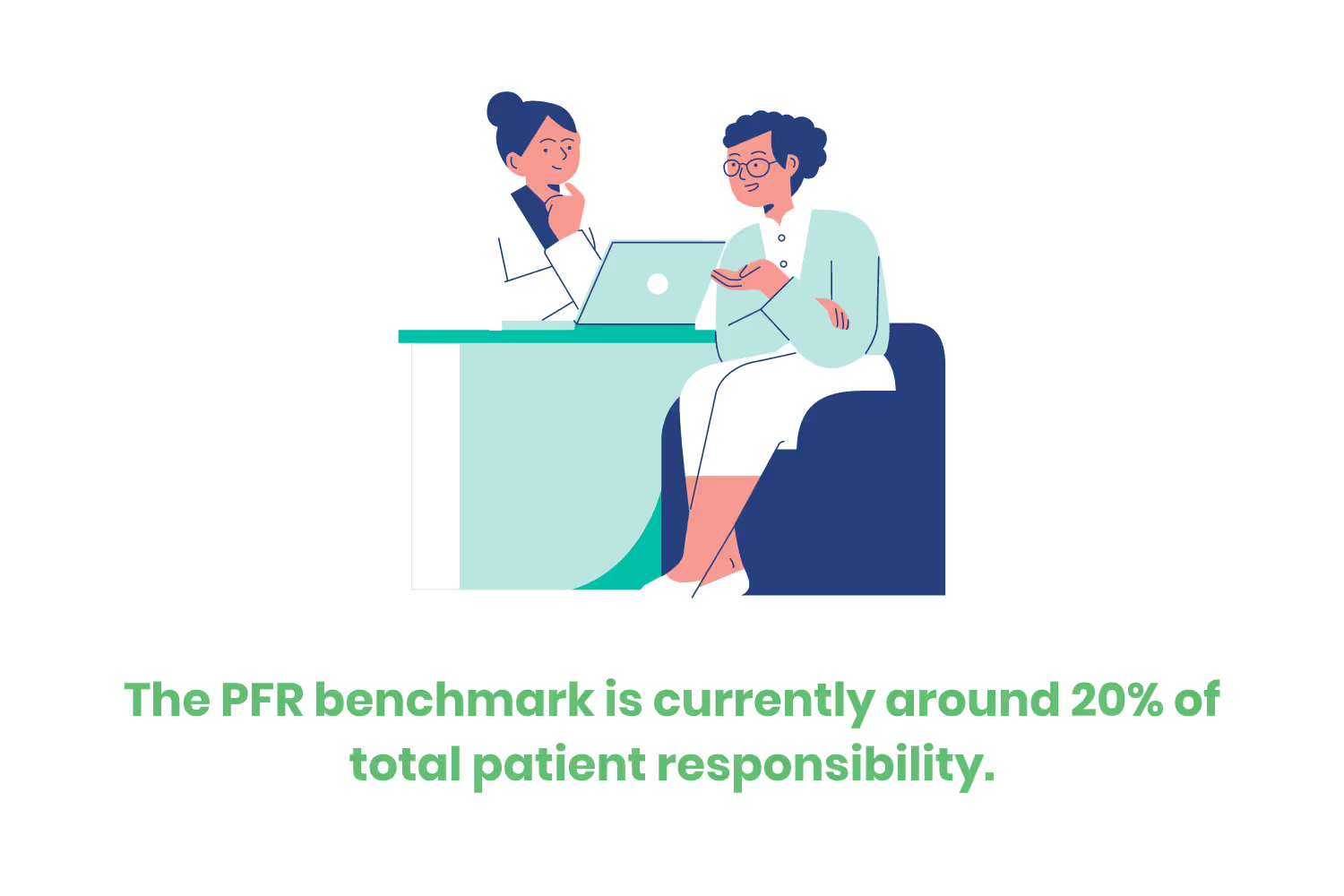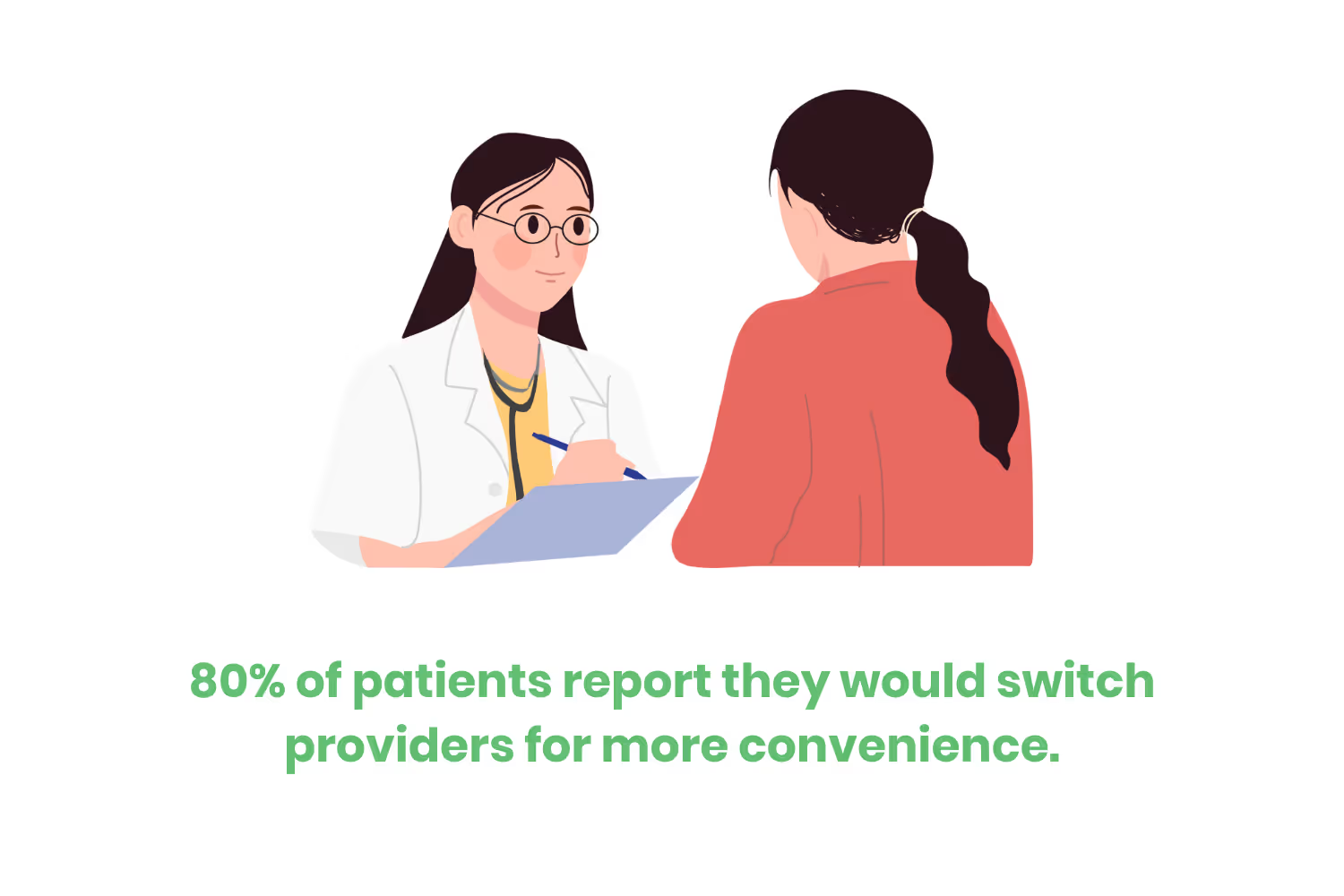Patient Financial Responsibility: An Ultimate Guide
So what exactly is PFR and how should you go about tracking it? What should you do to make sure your patients are paying their bills promptly? Let’s get into it.

NRC Health reports that 68% of patients feel frustrated by the healthcare billing processes. The same study shares that 80% of patients report they would switch providers for more convenience. When it comes to patient financial responsibility (PFR), we are talking about out-of- pocket expenses. These include the following:
- Copayments - When a patient with a health insurance plan must pay a fixed dollar amount at the time of a medical service. The insurer is then responsible for the rest of the reimbursement.
- Deductibles - Fixed dollar amount that an insured person pays before the payer covers medical services. After paying the deductible, a patient usually only must pay the coinsurance or copayment.
- Coinsurance - The cost an insured person pays for healthcare services after they meet their deductible.

It’s important to remember that payers are not the only direct influence on your organization’s financial health. Collecting payment is often an underemphasized piece of the revenue cycle management system. So what exactly is PFR and how should you go about tracking it? What should you do to make sure your patients are paying their bills promptly? Let’s get into it.
Why is PFR Important?
We went over the basics of PFR, but why should businesses care about it? Familiarizing yourself with tracking this metric will help you understand patients’ ability to pay. As well as insight on how to create different strategies to improve collections while reducing debt.
Organizations will use PFR to evaluate the effectiveness of their current processes. The two most important aspects to keep in mind when it comes to financial responsibility are…
- Patient education
- Patient communication

The PFR benchmark is currently around 20% of total patient responsibility. This is essential to keep in mind to better understand what revenue to expect from their patients. It also helps you accurately calculate PFR.
To calculate PFR, add up all of the out-of-pocket costs that the patient is responsible for in a given period. Things such as deductibles, coinsurance, and co-payments. Include any outstanding balances, and calculate the percentage of the total collected. Compare this to industry standards to determine how well your practice is performing.
Utilizing electronic health records (EHRs) and other billing systems helps you calculate PFR accurately. These tools shed light on a patient’s insurance coverage and services provided. Closely monitoring this metric of the healthcare revenue cycle management system helps you improve your financial status. It also helps you streamline billing processes.
Improve Your PFR Rate
Now that you better understand what PFR is and how to calculate it, let’s talk about how to use it to improve the collection of patient payments. To keep your PFR rate around 20% of total patient responsibility, you can go about this in a few ways. Through education and training, payment plans, and more. Let’s get into the details about each of these strategies and how they can help you collect your revenue faster.

Education
Making sure your patients understand their financial responsibilities should be priority number one. Before they receive their services, you should make sure they understand what to expect during the billing process. This, of course, encourages clarity and transparency.
At the end of the day, avoiding confusion boils down to one thing…communication. With solid communication, it doesn’t matter if a patient has insurance or pays out-of-pocket. One way to do this is by handing out brochures and paperwork before an initial appointment. Or, even adding financial responsibility information on your company website.
Of course, you should always have a discussion about these responsibilities with your patient. Ideally, do this before the appointment. Include any information about their insurance coverage, co-pays, and deductibles they should be aware of beforehand. As well as any out-of-pocket expenses they might have.
Verify Insurance Eligibility
Remember to verify your patient’s insurance eligibility before providing healthcare services. Doing so can help you ensure clarity and transparency while working with PFR. Verifying this allows providers to better predict the patient’s financial responsibility. Before performing services, knowing what the patient’s insurance covers can reveal possible upfront cost estimates. This reduces the likelihood of unexpected bills and possible payment delays.

By verifying insurance, you are less likely to run into billing errors. Billing errors slow the revenue cycle management process. Mostly in the form of billing denials as well as payment delays. Avoid costly mistakes to better streamline your workflow by following this tip. You can verify a patient’s insurance by:
- Checking the patient’s insurance card.
- Contacting the insurance company.
- Using an online eligibility tool.
Payment Plans
Another way to ensure financial clarity between your practice and the patient is to incorporate payment plans. Giving people a way to manage their financial obligations in a way that makes them feel comfortable produces many benefits. This leads to greater trust between you and the client. It also reduces the likelihood of delinquencies or delayed payments on balances. To avoid missed payments, you might want to take the time to assess the following:
- Patient income.
- Credit history.
- Current financial situation.
Ensure patient satisfaction and meet compliance regulations by verifying payment eligibility early on. Make sure you communicate this option before performing medical services.

Use Technology
Technology assists your practice in staying open. It also provides transparency with patients about their healthcare costs.
You can offer online portals, mobile apps, and text reminders to keep patients informed on their payment due dates. These portals can also offer patients the following:
- Detailed breakdowns of their medical bills.
- Access to view insurance coverage information.
- Information on patient financial responsibility before receiving medical care.
The convenience of online payments makes sending and receiving revenue easier for both parties. Make sure you are utilizing secure payment portals when handling online patient payments. Electronic health records (EHR) systems allow practices to integrate their payment portals securely. That way patients can take care of their bills easily using the following convenient methods:
- Credit/debit cards.
- Bank transfers.
- Digital wallets.
- Automated payment plans.

Train Staff
By keeping your staff well-trained, you ensure seamless communication between the billing team and your patients.
Billing processes, complex insurance terms, and other coverage details are better explained through direct contact. By training your staff, you ensure your patients understand their financial responsibilities. And, you foster a positive patient experience and build professional trust.
This reduces any confusion and frustration which has to do with financial matters. Providing clear explanations and offering assistance with the payment will lead to improved revenue capture.
Monitor and Analyze Metrics
By monitoring and analyzing key metrics, you’re capitalizing on several benefits for your organization.
Examples of key metrics to keep an eye on include:
- Patient payment behavior.
- Reimbursement rates.
- Collections performance.
- Facilities can identify trends.
- Pinpoint areas for improvement.
- Optimize revenue cycle management processes.
When providers continuously monitor these metrics,
Analyzing these metrics also provides valuable insights into patient preferences. These metrics help tailor financial policies and enhance patient financial experiences. Furthermore, these metrics help…
- Mitigate financial risks
- Ensure compliance
- Drive continuous improvement in financial performance and operation
Ultimately, leveraging data-driven insights enables healthcare facilities to achieve financial sustainability. It also helps you deliver high-quality care while reducing the financial burden on patients.
Conclusion
PFR remains a critical metric of measurement. Especially when it comes to collecting on patient payments. Not only is the influence of this concept on your financial health important, but for your patient satisfaction rate as well. The example from NRC highlights the already frustrating relationship between patients' billing processes. Having the power to streamline communication between you and the patient will only benefit your bottom line.
With data-driven insights, you can achieve and maintain financial sustainability. All while delivering high quality care and retaining your client base. Alleviating financial burden on your patients will have them returning as regular patients. This forges a sense of trust and respect. While you prioritize your PFR management, you are also investing in creating a positive work environment. Lessening the burden on your billing team by better streamlining services.
Emphasize your product's unique features or benefits to differentiate it from competitors
In nec dictum adipiscing pharetra enim etiam scelerisque dolor purus ipsum egestas cursus vulputate arcu egestas ut eu sed mollis consectetur mattis pharetra curabitur et maecenas in mattis fames consectetur ipsum quis risus mauris aliquam ornare nisl purus at ipsum nulla accumsan consectetur vestibulum suspendisse aliquam condimentum scelerisque lacinia pellentesque vestibulum condimentum turpis ligula pharetra dictum sapien facilisis sapien at sagittis et cursus congue.
- Pharetra curabitur et maecenas in mattis fames consectetur ipsum quis risus.
- Justo urna nisi auctor consequat consectetur dolor lectus blandit.
- Eget egestas volutpat lacinia vestibulum vitae mattis hendrerit.
- Ornare elit odio tellus orci bibendum dictum id sem congue enim amet diam.
Incorporate statistics or specific numbers to highlight the effectiveness or popularity of your offering
Convallis pellentesque ullamcorper sapien sed tristique fermentum proin amet quam tincidunt feugiat vitae neque quisque odio ut pellentesque ac mauris eget lectus. Pretium arcu turpis lacus sapien sit at eu sapien duis magna nunc nibh nam non ut nibh ultrices ultrices elementum egestas enim nisl sed cursus pellentesque sit dignissim enim euismod sit et convallis sed pelis viverra quam at nisl sit pharetra enim nisl nec vestibulum posuere in volutpat sed blandit neque risus.

Use time-sensitive language to encourage immediate action, such as "Limited Time Offer
Feugiat vitae neque quisque odio ut pellentesque ac mauris eget lectus. Pretium arcu turpis lacus sapien sit at eu sapien duis magna nunc nibh nam non ut nibh ultrices ultrices elementum egestas enim nisl sed cursus pellentesque sit dignissim enim euismod sit et convallis sed pelis viverra quam at nisl sit pharetra enim nisl nec vestibulum posuere in volutpat sed blandit neque risus.
- Pharetra curabitur et maecenas in mattis fames consectetur ipsum quis risus.
- Justo urna nisi auctor consequat consectetur dolor lectus blandit.
- Eget egestas volutpat lacinia vestibulum vitae mattis hendrerit.
- Ornare elit odio tellus orci bibendum dictum id sem congue enim amet diam.
Address customer pain points directly by showing how your product solves their problems
Feugiat vitae neque quisque odio ut pellentesque ac mauris eget lectus. Pretium arcu turpis lacus sapien sit at eu sapien duis magna nunc nibh nam non ut nibh ultrices ultrices elementum egestas enim nisl sed cursus pellentesque sit dignissim enim euismod sit et convallis sed pelis viverra quam at nisl sit pharetra enim nisl nec vestibulum posuere in volutpat sed blandit neque risus.
Vel etiam vel amet aenean eget in habitasse nunc duis tellus sem turpis risus aliquam ac volutpat tellus eu faucibus ullamcorper.
Tailor titles to your ideal customer segment using phrases like "Designed for Busy Professionals
Sed pretium id nibh id sit felis vitae volutpat volutpat adipiscing at sodales neque lectus mi phasellus commodo at elit suspendisse ornare faucibus lectus purus viverra in nec aliquet commodo et sed sed nisi tempor mi pellentesque arcu viverra pretium duis enim vulputate dignissim etiam ultrices vitae neque urna proin nibh diam turpis augue lacus.




